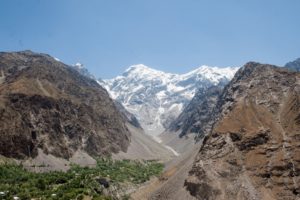Big-Time Glacier Melt Not at the Poles

“In a land of glaciers, even optimism is receding”
Appearing on “The World” page of a recent Washington Post edition, the subtitle to Tim Craig’s piece reads: “The villages of Pakistan’s scenic valleys are coming to terms with what life might be like when the ice is gone.”
You have a sense of foreboding already, don’t you, ’cause it may not be that far in the future when anything having to do with glaciers, icebergs and ice sheets around the globe will be about how their disappearance is impacting all manner of life as we know it?
“‘We worry it may even vanish and there will be no drinking water,’ said Abdul Nasir…pointing up to the 19,000 ft. [Miragram] mountaintop streaked with thin, patchy snow. ‘Every year it’s melting,'” he adds.
Craig says many studies show: “With 7,253 known glaciers, including 543 in the [scenic] Chitral Valley, there is more glacial ice in Pakistan than anywhere on Earth outside the polar regions…”
Then: “…to many, the 1,000-square-mile Chitral Valley has become a case study of what could await the rest of the world if climate change accelerates, turning life-supporting mountains into new markers of human misery.”
Craig reports that the population of the Valley has soared to 600K today, more than 4 fold what it was in 1950. That compares to a global population increase of about 2.7x over the recent 6 decades.
Because the Valley’s population is served by electricity between 2 and 4 hours/day, vendors hawking ice chunks for refrigeration and drinking are, as one might say, doing a land office business.
Driving into the mountains for upwards of 7 hours, 3-4 yds3 of ice weighing some 3-4MT are then loaded onto jeeps and trucks and driven back to the residents of the Valley. This amount of ice, according to a local biodiversity expert, can supply 4-7 families with drinking water for several days. Daily so-loaded truck trips number about 200.
Another sorry statistic: summer snow lines on Pakistan’s mountains have receded by an average of almost 3,400 ft. since 1981. It has 14 of the world’s highest peaks at 26,000 ft. or more.
A concomitant result is that, according to the head of Pakistan’s Meteorological Department, “the annual South Asia monsoon is growing more dynamic as temperatures spike over land and clash with cooler ocean water. Now, instead of the late summer monsoon affecting mainly south and eastern Pakistan, it has also been pumping deluges over the mountains.”
Interestingly, the article quotes a climate-change denier among Pakistan’s own who thinks that Pakistanis are themselves responsible for the melting ice packs. That person claims goat herders, tourists and even the army are allowed to trek over the tree roots that stabilize the glaciers. Those trodders would be the cause of glaciers receding.
This same climate-denier is quoted as uttering what seems to me one of the all-time ironic statements: “People say global warming, but in fact, it’s human activity” that is causing glacier melt. (Maybe there was a translation glitch?)
Apple, for one, to the rescue-
Did you know that some of the largest corporate consumers of electricity have formed their own green grids?
In June 2015 I wrote about Google’s foray into energy production. Now Apple’s getting into the act with its energy subsidiary having just received FERC designation as a wholesaler of green electricity across the country. Google’s designation came in 2010. To be clear, these companies’ main, if not sole, customers are themselves.
 Actually, Apple has contracted with First Solar for about half of its power needs which, last year, totaled some 831M kWhs. Apple’s requirement would power about 76K homes annually, the approximate rooftop count in cities such as Little Rock, AR, and Glendale, CA.
Actually, Apple has contracted with First Solar for about half of its power needs which, last year, totaled some 831M kWhs. Apple’s requirement would power about 76K homes annually, the approximate rooftop count in cities such as Little Rock, AR, and Glendale, CA.
First Solar is constructing a plant outside Cholame, CA (northwest of Bakersfield), that will service the Apple contract. Something I find interesting is that the ground-mounted solar panels there will have rotator hinges built into the struts, allowing the panels to literally follow the sun through the day. (Innovation!)
What’s driving this is the power needed for Cloud-based computing among high-tech companies such as Apple, Amazon and Google. Retail locations is another driver for Apple; and for Walmart, another big investor in green energy.
The generating capacity of clean energy in our country has doubled each year since 2013. Last year 11 companies agreed to purchase 3.23 gigawatts from green power providers. Diane Cardwell, reporting in The Washington Post, says that’s the equivalent of 5 coal-burning plants.
11 big companies taking 5 coal plants “off-line” as to GHG emissions won’t solve the receding glaciers in Pakistan real soon, but it’s a real, measurable step in the right direction.